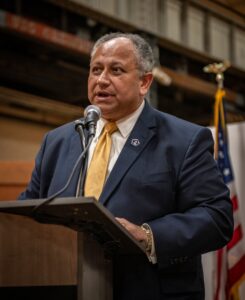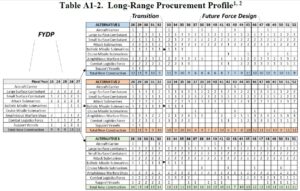The Navy’s upcoming 30-year shipbuilding plan will likely repeat last year’s plan pattern of presenting three options, the Secretary of the Navy said this week.
“Unless things change dramatically, I think it will. It’ll have three options there and I think that’s a good strategy – it provides options for future leaders to be able to make decisions based on the current threat of the day,” Carlos Del Toro said Wednesday during the annual McAleese Defense Programs Conference.

Last year, for the first time, the Navy submitted a 30-year shipbuilding plan to Congress that contained three options, two assumed a flat top line department budget that could have the fleet reach 318 or 322 ships by 2045 while the third option assumed $75 billion in real growth after five years to reach 363 ships by 2045 (Defense Daily, April 20, 2022).
While several congressional defense committee leaders and members did not appreciate the tripartite plan, the final budget bill was closer to the third option of increased funding levels.
Navy and DoD officials have been unwilling to disclose when they specifically expect the 30-year plan to be released.
During a reporter roundtable ahead of the budget release on March 10, Under Secretary of the Navy Erik Raven said, “we’re working to deliver that very soon,” without elaborating.
During the March 13 full budget rollout, Deputy Secretary of Defense Kathleen Hicks said she would defer to the Navy Secretary on timelines for the shipbuilding plan and just said “we have every expectation that we’re going to be submitting this shipbuilding plan here in the near term.”
Del Toro did disclose that this year’s plan will repeat some elements from last year’s three-option plan in that the first 10 years of the plan share the same numbers.
“If you look at the numbers very carefully, you’ll see that in the first 10 years of that plan, the numbers don’t change. And that’s important, because the industry does need a steady signal of what our intentions actually are…take a look at the numbers in those first 10 tables and you’ll see a tremendous amount of stability and flexibility, even compared to last year.”

Del Toro argued providing three options beyond 10 years out provides future leaders with options as the world changes.
“What will the world look like in 10 years from now? Or 15 years from now?…Well, it’s hard to predict. And I think what having the three courses of actions there allows current leaders and future leaders, both in Congress and in the executive department to do, is to be able to have the flexibility necessarily, to look at those different options.”
Last month, Del Toro announced he tasked the Navy with creating a new 30-year long-term infrastructure plan inspired by the shipbuilding plan to gain a better understanding of the service’s facilities. He said the aim is to stay ahead of installation issues like the Red Hill Bulk Fuel Storage Facility, Naval Support Activity Bethesda barracks, and drydocks (Defense Daily, Feb. 21).
Del Toro said the infrastructure plan is expected to be developed as part of the FY 2025 or 2026 budget request process.